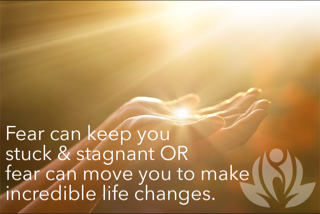|
Feeling more stressed out than usual? You’re not alone. Results of a recent survey by the American Psychological Association (APA) prove that stress levels for Americans have steadily increased since the election, for both Democrats and Republicans and those in between. The APA survey results attribute this increase in stress directly to heightened worries, fears and uncertainty over the election, the future of our nation and what all this means for the day-to-day functioning of our lives. But this blog isn’t a piece about the election, it’s about fear, and what to do with it when it feels excessive or just too much to deal with. Fear can rock your soul, upend your life or even serve to save your life – we are biologically hard-wired to feel fear as a necessary survival mechanism after all. Fear can keep you stuck & stagnant OR fear can move you to make incredible life changes. Whether you spend more time giving into it, fighting it, inventing it or avoiding it, fear is an ever present and natural part of life. In fact, it’s nearly impossible to be alive and not encounter fear at some point. Yet it’s when our innate physical fear responses become overwrought or confused and go haywire that we can feel more vulnerable and deeply uncomfortable. That’s when it’s time to reevaluate and work on your relationship with your fear. Move Beyond Fear: 3 Steps to Successfully Relate to Your Fear First, locate your fear. By this, I mean find out where and how your fear lives in your body and mind. Is it an overall numbness, a tendency to escape, or uncontrollable anxiety? Although the inclination is to get as far away from your fear as possible or try to avoid it or muscle through it, these coping strategies, while beneficial at times, don’t always lead to successful resolution of your fears. Discovering where the fear lives in your body and your mind is the first step to developing a new relationship with your fear. Next, get intimate with your fear by developing a dialogue with it. What is the main narrative and core belief of the fear? Does it stem from a past traumatic event, the current state of things in life, or a general tendency towards an overly worried or hypervigilant mindset? Fear can come from any number of sources – lack of environmental or relational supports, traumatic events, false beliefs about yourself or the world or just plain old fear of uncertainty. Whatever the case may be, asking important questions helps you discover what the fear is really made of. Finally, make new rules of engagement with your fear. Playing by the same old habitual ways of relating to your fear will get you nowhere. In other words, if you meet your fear with fear, it will only compound it. Once you locate your fear, find out what it is made of and learn to dialogue with it, it’s up to you to change the rules on what and how you relate to it. Taking time to meet yourself and your fears in a safe and supportive space with an attitude of curiosity and compassionate interest is essential. |
Understanding the Mental Health Needs of the LGBTQ+ Community in Today’s World
After 25 years in the field of mental health, one truth has remained constant: healing cannot happen without the presence of safety, understanding and compassion. I’ve worked with individuals from all walks of life—people grappling with anxiety, trauma, grief,...



